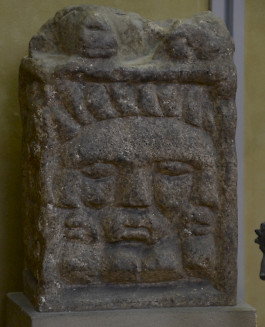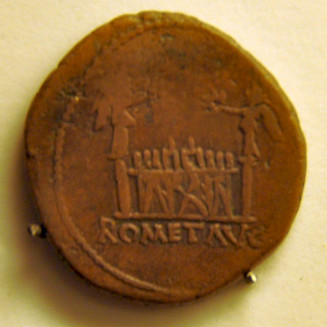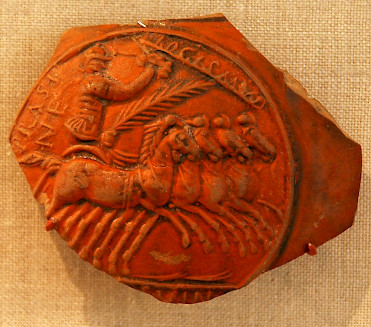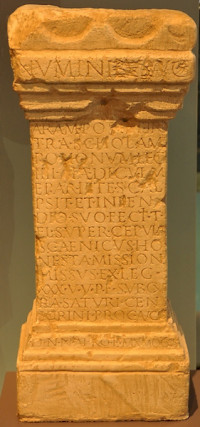Lugdunum (Lyon)
Q21816312Lugdunum: main Roman city in the "three Gauls", site of the imperial cult, modern Lyon.
Early History

In the area of what is now called Lyon, two Celtic settlements, probably inhabited by the tribe of the Segusiavi, have been identified, which date back to the La Tène period (e.g. after 450 BCE). The first of these was an oppidum on the west bank of the Saône on a hill called Fourvière. The other town was located between the Saône and the Rhône. This second town may have been called Lugudunon (“hill of Lugus”; attested on a coin from 42 BCE), from which Latin Lugdunum was derived.
Situated near the confluence of two important rivers, one connecting the area with the Moselle and Rhine, the other leading in the general direction of the Upper Danube, we can imagine early Lyon as a trade center. This is confirmed by the presence of Italian amphoras and Greek pottery.
Roman Conquest
The Romans conquered the valley of the Rhône from the south, first subjecting the Allobroges in c.120 BCE. Having gained control of the area, the Romans founded the city of Vienna, modern Vienne. When an Allobrogian leader named Catugnatus revolted and expelled the Roman merchants, the latter went up north and took over Lugdunum. In this confused situation, the Helvetii announced that they would migrate downstream along the Rhône and proceed to Aquitania, which was sufficient for the Roman general Julius Caesar to intervene. In 58, he captured the hill of Fourvière, which was to remain one of his bases during the subsequent war in Gaul.

The city was formally organized as a colonia after the death of Caesar by Lucius Munatius Plancus (43 BCE); the first inhabitants must have been veterans from Caesar's legions. For some time, Lyon had the privilege of minting silver coins, which made it necessary to garrison the town: the Cohors XIII urbana was to remain in Lyon for two centuries.
In the thirties of the first century BCE, the Romans organized the "three Gauls" conquered by Caesar, converting them into three provinces and creating a network of roads. General Agrippa, the right-hand man of Caesar's heir Octavian, built important roads: one from Lyon to Bordeaux in the west, one from Lyon to Geneva and Augst in the northeast, and one from Lyon to the north, bifurcating in a road to Reims in the northwest and a road to Trier and Cologne in the northnortheast.
In 12 BCE, the Romans dedicated an altar to Roma and Augustus on the Croix-Rousse Hill.note Every year, Gallic leaders would gather here to discuss affairs. The conquest was over; Lyon had become the capital of the Three Gauls.
Roman City

Although Lyon was an important center of Roman government, it never became a city like Carthage, Ephesus, Antioch or Alexandria. Still, it covered some 350 hectares and had more than 30,000 inhabitants (twice the size of Pompeii and about as many as Cologne), and was considered the largest city in Gaul after Narbo.note Lyon boasted a forum, a temple of Roma and Augustus, a sanctuary for Cybele, an aqueduct, a theater, an odeon, and an amphitheater for chariot races. Most importantly, it was a city where all kinds of traders and merchants met.
Several emperors and princes visited the city. When Drusus visited the city in 10 BCE, his wife Antonia gave birth to a son, Claudius, the future emperor).note The emperor Caligula resided in Lyon during his northern tour.note In 68 CE, the city was focus of the insurrection of Vindex, which was suppressed but led to the downfall of the emperor Nero. Trajan and Hadrian, who visited the city in 119, constructed monuments. In 185, the future emperor Caracalla was born in Lyon.
In an international city, there would be people from the east, including exiles (e.g., the Herodian tetrarch Antipas of Galilee) and Christians. In 177, they were cruelly persecuted; the Acts of the Martyrs of Lyon is a terrible source to read. After this event, Irenaeus became bishop, one of the first Christian leaders to focus on orthodox faith.

After the unlucky reign of Publius Helvius Pertinax (in the first months of 193) and the coup of Didius Julianus, there was the countercoup of Lucius Septimius Severus, who had a rival in the west, Clodius Albinus. Severus defeated Albinus in a battle near Lyon.note Because the garrison of Lyon, the Cohors XIII urbana, had sided with the latter, Septimius Severus ordered subunits of two legions (VIII Augusta and XXII Primigenia) to serve as garrison of Lyon.
Late Antiquity
After the mid-third-century, the Rhine border was threatened and the seat of the Roman government was transferred to the northeast, where Cologne, Mainz, and Trier became increasingly important. For Lyon, this was the beginning of a slow decline. There were no funds to restore the aqueduct, so important for a large city, when it had fallen into disrepair. Still, the city was frequently visited by emperors (e.g., Constantine the Great) and usurpers (e.g., Magnentius, who committed suicide in Lyon).
Lyon remained an important Christian center, though, with an episcopal palace on the banks of the Saône, a baptistery and a church that was dedicated to John the Baptist (the present cathedral). On the ancient cemeteries outside the walls, several funerary basilicas were constructed.
In 460, Lyon became the residence of the Burgundians, who were eventually conquered by the Franks in 532.